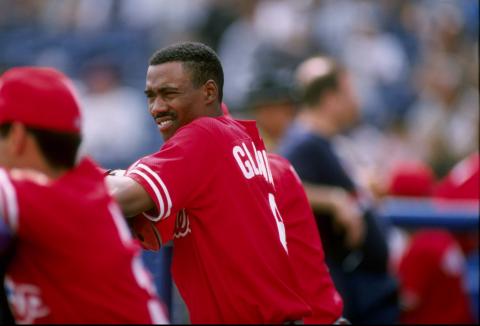Don't Judge Baseball Players by Their Metrics - Or Their Background
New York Times
March 28, 2018
By Doug Glanville
Numbers won't tell you what kind of teammate a player is.
If you’ve ever been a professional baseball player, you know that every year for spring training you arrive at camp with a host of teammates you’ve never played with before. You may know them as opponents, or maybe you know nothing at all.
In such situations it’s easy to default to the simplicity and comfort of one’s assumptions. And to be consistent with the preferred evaluative framework of baseball is to judge by the numbers: You can determine someone’s level of discipline by his on-base percentage, say, or his precision by his strikeout-to-walk ratio.
But metrics won’t tell us what kind of teammate he will be.
The new season is here and 30 major league teams have finalized their rosters. Each will contain 25 players from a variety of backgrounds. In my first spring training with the Chicago Cubs, my locker in the clubhouse physically placed me between the quiet strength of the Hall of Famer Ryne Sandberg, who advised through action and a whisper, and the exploding intensity of Randy Myers, an avid fan of military equipment (including the Hummer he drove before it turned “luxury”), whose locker was full of Tasers and camouflage gear. Both were All-Stars; you wanted both on your team.
We also had the vociferous Shawon Dunston, an African-American Brooklyn native who spoke plainly and directly on issues, which often caught the attention of the Caucasian So-Cal dude Mark Grace. Their epic debates were conducted with a mutual respect and genuine brotherhood, even though one could be seen as the photographic negative of the other. They were teammates who respected the game and each other, and I learned from both. (Shawon taught me about hustling on every at-bat, no matter how many hits you got that day, and Mark taught me about finding advantages, right down to using the shadows in a day game to see where the catcher was setting up, which helped anticipate the location of the coming pitch.)
It was years of being on teams — some successful, many not — that gave me empirical evidence about how they were constructed. Many experts have since tried to quantify chemistry, or come up with a formula that makes up championship locker rooms. Yet no algorithm can explain why in 2002 many of my Phillies teammates and team officials made a two-hour trip to pay their respects at my father’s funeral. Or why Jim Thome — now a newly minted Hall of Famer — celebrated his 400th home run in 2004 by popping champagne with all of us Phillies, making us feel like we’d all helped him achieve that milestone.
Assessing a player is complicated, especially without the context that comes with daily engagement, and the assumptions we make are not just statistical but cultural — even when we know, for instance, that being from Mexico is not the same thing as being from Venezuela, no matter who we lump into the category “Latin American.”
So the player from Santo Domingo, in the Dominican Republic, the player from rural Nebraska and the player from Detroit all evoke certain preconceived notions. Today especially, in much of our American stereotypical box-checking discourse on identity, those geographic and cultural truths can prevent us from seeing the frequent counternarratives to our biases, those revealed from real intimacy and consistent proximity through a unified goal. Team discord is sowed when we are reduced to living exit polls, tied to a sound bite or the color of a state.
But I have found that baseball at its best is better than that.
It is tempting in a hyper-responsive and reactionary world to take a data point and extrapolate. Today it’s not enough to have information; we need to assign it meaning in real time. We must name people’s tunes in one note, even when they were about to play you their entire composition anyway. We are effectively giving a pitcher a Cy Young Award after one outing, or handing over the Gold Glove Award after one spectacular catch. And that is only the positive side of such premature judgment.
By the time a season comes to a close, every player will have reached a new set of conclusions about his teammates — for better or worse. We will have found out who we want on the mound for the big game, who outworks everyone else in the weight room, who treats our family like his own even when the camera is not rolling, who would play hurt and run through a wall to make that great catch. There are few places to hide our real selves, and our biases are constantly being challenged, even negated.
So when we focus purely on the game at hand, on the field, give me Curt Schilling (society’s box: white, privileged, alt-right conservative) to pitch Game 7, Kenny Lofton (society’s box: flashy, radical, outspoken black guy) to lead off and Bobby Abreu (society’s box: nonchalant, sports-car-driving Latino) to get on base by bat or by walk.
Being on a team means that information is always coming in under the game’s requirement to be productive every day. Conversely, a season, not just an at-bat, or a half-inning, shows us, unequivocally, that we need the full breadth of time to really learn the mettle of a person.
Without this repeated exposure, it’s hard for us to reconcile why the Dominican legend Sammy Sosa listened to Whitney Houston on loop (music that came after her hit-making years) in the Cubs clubhouse, or how Bruce Chen (who, with his Chinese heritage, physically fits our “Asian” box) could actually be from Panama and, of course, be fluent in Spanish.
We learn, also, why the world stops for all players when we lose one of our baseball brothers — like the breathlessness I felt when Darryl Kile, who I didn’t even know, passed away in his hotel room one season. Or how, despite the complicated politics around Cuba and the United States, it moved many of us to tears when our teammate Eddie Oropesa, who had defected from Cuba, finally made it to the major leagues and reunited with his family in the dugout. That day, we learned about risk and sacrifice through the road he’d traveled.
On every roster this Opening Day, there will be a rookie. Scared about his future, scared about his family, but open to input. He represents opportunity — not only his professional opportunity but also a cultural one for the rest of us. The daily experiences that he will have now, set on common ground with common goals, will reveal to him what really counts in a teammate and a person. It’s an environment that gives intimacy a chance to inform him about people, as opposed to a clickable universe of labels and boxes.
Republished from The New York Times
Photo Caption: The writer, a former outfielder, at spring training 1998.
Photo Credit: Jonathan Kirn/Allsport, via Getty Images






